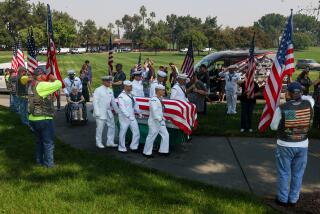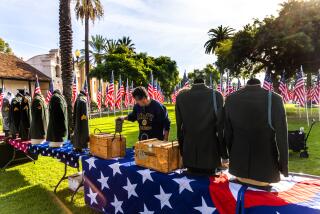WWII soldier’s tale is finally told decades after his death
- Share via
VORSELAAR, Belgium — A brass band waited outside the church, the musicians bundled in overcoats and scarves against a gray morning. Someone hoisted a ceremonial flag as we proceeded down cobblestone streets in this small town.
The air had turned cold enough to show our breath by the time we passed through an iron gate to the cemetery, following a path that led to a headstone draped in a Canadian flag.
The mayor of Vorselaar said a few words in Flemish that my brothers and I did not understand, after which another man read from a prepared text. Soon enough, it was my father’s turn.
PHOTOS: A war hero’s untold tale
In a quavering voice, he said, “Our gratitude goes beyond words.”
His speech lasted less than four minutes and, before it ended, several of the townsfolk had tears in their eyes.
My family had traveled across the Atlantic to be with these people, complete strangers. We had assembled on a Sunday in late autumn to honor a man whom none of us had ever met.
My grandfather.
***
My middle brother, Jon, says that Clifford Wharton was like some kind of legend or myth, but I think he’s overstating things.
To me, Clifford was simply a black-and-white photograph of a young man in soldier’s garb with his garrison cap tilted at what they used to call a jaunty angle. Our family rarely talked about him and, for the better part of 50 years, I knew only the basic facts.
In the late 1920s, he left his seaport home in England — the shipyards were struggling — to start a new life. Settling in western Canada, he found work as an auto mechanic and met my grandmother, Leona. They had been married only a few years and she was pregnant with their first child when Canada joined World War II.
Much later, I was told that Clifford shipped off to England, where he trained as a demolitions expert and attained the rank of company sergeant major in the Royal Canadian Engineers. Somewhere in Belgium in the fall of 1944 — we never knew exactly where — he came across a German antitank mine.
The explosive detonated when he attempted to defuse it. He was buried with other Commonwealth soldiers in Antwerp, half an hour to the west.
There was nothing sinister or particularly unusual about his story, and there was no reason to keep it a secret.
By the time I came along, my grandmother had long since been remarried to a kind man who had survived a stint in the Devil’s Brigade, one of the war’s most daring commando units. Clifford’s name hardly ever came up.
“It probably wasn’t a subject that was appropriate,” my father, Lyle, said. “And his story did not run deep in our family. His presence was so brief.”
***
An ocean away, Marc Op de Beeck had reasons for digging into our personal history.
He is also the descendant of a Canadian soldier. His grandfather met a Belgian woman during the war and brought her back to Prince Edward Island. They had a daughter who, years later, on summer vacation, fell for a man in Vorselaar and moved there to be with him. Op de Beeck is their son.
This circular family history made him curious about World War II and Canada’s role in liberating Belgium from hard years of Nazi occupation. Soft-spoken and precise, the 39-year-old auto parts salesman said: “I’m always searching the Internet. Looking for things.”
For years, Vorselaar had maintained the grave site of a Canadian pilot who had crashed in a nearby field. Lt. J.W. Cowling was thought to be the only Commonwealth fighter to die in the town, though he was only in the town for a split second.
In the local archives, Op de Beeck found mention of a wartime explosion at the Borrekens castle, a nearby medieval fortress with proud towers and battlements made of sandstone. The baron who lived there seemed to recall that a Canadian soldier had been killed.
This discovery started Op de Beeck on a two-year search. He found an old photograph that showed code numbers for all the Canadian forces deployed in the region. Further research helped him translate those numbers into actual units.
Corresponding with officials in Ottawa, he obtained the military diaries for several likely units, scanning hundreds of pages for an entry about the explosion.
“All of sudden, hey, there it was, your grandfather’s name,” he recalled. “It was a little bit of luck.”
Further requests got him copies of Clifford’s personnel file and an official inquiry into his death. Still, Op de Beeck wanted more.
The documents showed that, after the war, the government had sent monthly checks to Clifford’s widow in San Francisco. Leona had long since died, but an Internet search turned up the name Lyle Wharton, who had graduated from USC in the 1960s.
“That was also in California,” Op de Beeck said. “I decided to give it a try.”
Through a series of emails in 2011, he found Lyle in Vancouver, Canada, asking him: Are you the son of Clifford Wharton?
***
Quite suddenly, my family was talking about Clifford.
With Op de Beeck passing along documents and asking questions, we were adding color to that old photograph of a young soldier.
It turned out that my grandfather had enlisted in large part so that his older brother, Stan, an officer in the voluntary militia, would not have to go to war alone.
Like many Commonwealth soldiers, he spent years training in England, waiting to fight on the Continent. My grandmother sent him snapshots of home and the son he had never met, pictures that Clifford kept bundled in his military coat.
After D-day, his unit landed in France and pushed into Belgium, to the Flanders fields made famous by a World War I poem.
In Flanders fields the poppies blow
Between the crosses, row on row,
That mark our place; and in the sky
The larks, still bravely singing, fly
Scarce heard among the guns below.
Vorselaar was happy to accommodate a liberating force and the baron invited the 34th Field Company to set up camp at his castle. For the first week or so, the men maintained supply routes, cutting down trees, placing them side by side to form “corduroy” roads across soggy terrain.
Then, with the Allies preparing to drive farther north, Clifford was ordered to give a refresher course on clearing land mines. The 35-year-old sergeant major ventured out to gather different examples and brought them back to camp, some still live.
On Oct. 21, 1944, as the rest of the company assembled for morning parade, he attempted to disarm the trickiest mine in an outbuilding where the servants did laundry. It was a steel-encased Riegelmine 43, packed with TNT and armed with delicate fuses.
One account has Clifford sending his aides outside to be safe; another has him giving them permission to attend parade and collect their allotment of cigarettes.
Either way, he was alone when an explosion rocked the laundry room about 8 a.m., blasting stonework into the surrounding moat. It took some time for rescuers to find his body in the rubble.
He was not the only member of his family to die young. Two sisters died of illness and Stan, who survived the war, was later killed in a midair collision on a commercial flight. The youngest son, Jack, was the only sibling to survive into old age.
The military sent Clifford’s belongings back to Canada, where my great-aunt Yvonne intercepted the snapshots — some charred by the explosion — and kept them hidden for years. She gave them to my father after my grandmother died.
With each new detail, our image of Clifford grew fuller. My youngest brother, Chris, said, “It’s like meeting a distant relative for the first time.”
The facts were a good start but, much like Op de Beeck, we needed more.
***
My father went to Belgium first, in the winter of 2011.
After stopping by the military cemetery in Antwerp, he drove to Vorselaar to meet Op de Beeck and Lieven Janssens, the town’s good-natured mayor who presented him with a decorative plate. They visited the castle, blast marks still visible on the laundry room ceiling, and then the cemetery.
Trees bordered the well-tended grounds where hedgerows marked Cowling’s grave. Struck by the beauty of the place, my father mentioned that he wished Clifford had been buried there. Janssens, who lost a grandfather in the war, did not hesitate.
“We’ll make a place for him,” the mayor said.
The Commonwealth War Graves Commission, which maintains foreign burial sites, does not allow bodies to be moved, so Vorselaar made do with a replica headstone surrounded by ornamental plantings. The following autumn, my father brought my two brothers and me to attend a Remembrance Day dedication.
There was a Catholic Mass in the morning and scores of people walking in the parade. Then came the speeches at the cemetery, where something unexpected happened.
My father, not usually given to public displays of emotion, choked up as he unveiled the marker.
In that moment, it became clear that my family had needed to venture far from home to view Clifford through different eyes. We had needed the kindness of strangers to see him as something more than a legend or a set of facts in a government file.
Though much of my grandfather remained a mystery — the sound of his voice, the touch of his hand — there was enough of him in that chilly graveyard to raise tears and make voices tremble.
For the first time, my brothers and I could feel a connection. We could see the man behind the photograph.
twitter.com/LATimesWharton
More to Read
Sign up for Essential California
The most important California stories and recommendations in your inbox every morning.
You may occasionally receive promotional content from the Los Angeles Times.











